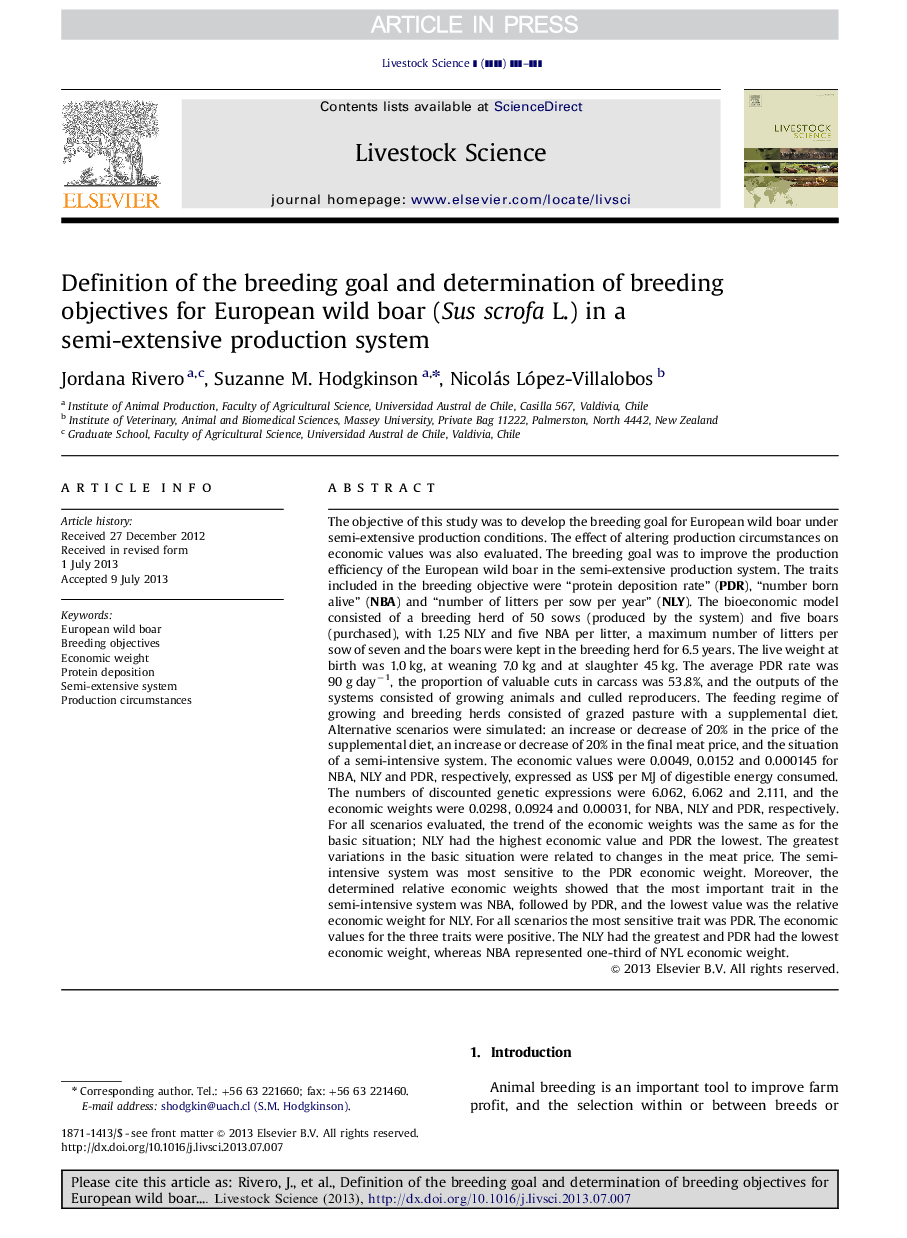| کد مقاله | کد نشریه | سال انتشار | مقاله انگلیسی | نسخه تمام متن |
|---|---|---|---|---|
| 5790345 | 1109492 | 2013 | 10 صفحه PDF | دانلود رایگان |
عنوان انگلیسی مقاله ISI
Definition of the breeding goal and determination of breeding objectives for European wild boar (Sus scrofa L.) in a semi-extensive production system
دانلود مقاله + سفارش ترجمه
دانلود مقاله ISI انگلیسی
رایگان برای ایرانیان
کلمات کلیدی
موضوعات مرتبط
علوم زیستی و بیوفناوری
علوم کشاورزی و بیولوژیک
علوم دامی و جانورشناسی
پیش نمایش صفحه اول مقاله

چکیده انگلیسی
The objective of this study was to develop the breeding goal for European wild boar under semi-extensive production conditions. The effect of altering production circumstances on economic values was also evaluated. The breeding goal was to improve the production efficiency of the European wild boar in the semi-extensive production system. The traits included in the breeding objective were “protein deposition rate” (PDR), “number born alive” (NBA) and “number of litters per sow per year” (NLY). The bioeconomic model consisted of a breeding herd of 50 sows (produced by the system) and five boars (purchased), with 1.25 NLY and five NBA per litter, a maximum number of litters per sow of seven and the boars were kept in the breeding herd for 6.5 years. The live weight at birth was 1.0 kg, at weaning 7.0 kg and at slaughter 45 kg. The average PDR rate was 90 g dayâ1, the proportion of valuable cuts in carcass was 53.8%, and the outputs of the systems consisted of growing animals and culled reproducers. The feeding regime of growing and breeding herds consisted of grazed pasture with a supplemental diet. Alternative scenarios were simulated: an increase or decrease of 20% in the price of the supplemental diet, an increase or decrease of 20% in the final meat price, and the situation of a semi-intensive system. The economic values were 0.0049, 0.0152 and 0.000145 for NBA, NLY and PDR, respectively, expressed as US$ per MJ of digestible energy consumed. The numbers of discounted genetic expressions were 6.062, 6.062 and 2.111, and the economic weights were 0.0298, 0.0924 and 0.00031, for NBA, NLY and PDR, respectively. For all scenarios evaluated, the trend of the economic weights was the same as for the basic situation; NLY had the highest economic value and PDR the lowest. The greatest variations in the basic situation were related to changes in the meat price. The semi-intensive system was most sensitive to the PDR economic weight. Moreover, the determined relative economic weights showed that the most important trait in the semi-intensive system was NBA, followed by PDR, and the lowest value was the relative economic weight for NLY. For all scenarios the most sensitive trait was PDR. The economic values for the three traits were positive. The NLY had the greatest and PDR had the lowest economic weight, whereas NBA represented one-third of NYL economic weight.
ناشر
Database: Elsevier - ScienceDirect (ساینس دایرکت)
Journal: Livestock Science - Volume 157, Issue 1, October 2013, Pages 38-47
Journal: Livestock Science - Volume 157, Issue 1, October 2013, Pages 38-47
نویسندگان
Jordana Rivero, Suzanne M. Hodgkinson, Nicolás López-Villalobos,